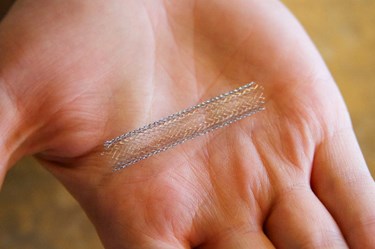Bioresorbable Polymers: The Next Generation In Stent Technology
By Doug Roe, Chief Editor

The science behind percutaneous coronary intervention (PCI), more commonly known as coronary angioplasty, has come a long way since the first balloon was inflated in the mid-seventies — with fingers crossed that it didn’t create a complete vessel dissection. Today, we have the technology for most patients, under virtually any circumstance, to receive PCI treatment.
Spurred on by device advancements, the global coronary artery disease market has grown to over $13 billion annually, led primarily by growth in coronary stents. Business consultant Smithers Apex predicts that the market will expand to $22.5 billion by 2021, with almost $15 billion directly attributed to stent consumption. There are various environmental (an aging world population), economic (emerging Asian and Latin American healthcare access), and safety (less invasive procedures) reasons for this growth, but the key driver behind this opportunity is continuous stent innovation.
Far from the technology’s crude beginnings — scaffolding designs used to decrease the rate of restenosis — today’s stents are cutting-edge architecture. The use of new metals, polymer coatings, and drug-elution techniques has vastly improved patient outcomes for those receiving these pioneering implantables.
Next-generation stent technology is and will be bio-absorbable or bioresorbable. To get a richer understanding of the current trends, I sat down with Craig Thompson, MD, who is SVP/CMO of Boston Scientific’s Interventional Cardiology. Dr. Thompson also provided insight behind the development efforts that created the SYNERGY Coronary Stent, the first bioabsorbable polymer drug-eluting stent system to receive FDA approval.
Med Device Online: Can you give an overview of Boston Scientifics’s SYNERGY technology?
Dr. Craig Thompson: Simply stated, Synergy is a bioresorbable polymer everolimus-eluting stent, constructed of ultra-thin struts made from a proprietary platinum chromium alloy, which we developed in-house. It is abluminally-coated — meaning the coating only is applied to the outer surface, where it will contact the vessel — with a completely bioresorbable polymer.
MDO: What considerations, related to current clinical outcomes, went into SYNERGY’s design?
Thompson: The idea was to develop a stent that would promote better healing. When you get better safety-related outcomes in your patients, there is more flexibility in being able to manage their treatment over time. What we have seen in the clinical community, over a number of years, with the first and second-generation durable polymer drug-eluting stent (DES) platforms, is a reduction in re-stenosis (“re-narrowing” of the vessel), which was intended and has been ideal.
But, [stent use] also has fostered abnormally healed blood vessels, and that condition leads to a couple of different challenges for patients. One is that it creates a higher risk environment for thrombosis, if a patient is removed from their anti-platelet therapy too early. So, the physicians and patients are tethered to this dual anti-platelet therapy for a year or more to prevent, or at least reduce the likelihood, that it will happen.
Then, over time, there tends to be an accumulation of safety events that, in aggregate, occurred in patients at a rate of about 2 percent per year, every year, after the implant of a permanent polymer DES. We believe that the lion’s share of these events is driven by chronic, long-term exposure of the artery to a permanent polymer without the continued protective effects of the drug, which disappears over the first few months in all current platforms.
MDO: What are some of the development challenges of a bioresorbable polymer-treated medical device?
Thompson: Historically, there was never ambition to have a permanent polymer inside of the blood vessel over a period of months and years. In the early development of drug-eluting stents, we had to settle on using a permanent polymer system. The ability, at the time, to have a polymer degrade and release drugs in a predictable manner, without causing inflammation in the blood vessel, really was not technically achievable.
That is why the development of this “synchronous” technology became transformative; now we have a system where you can deliver the drug with very low polymer loads. It is only four microns thick, which is basically nothing, a wafer-thin polymer on the outer surface of the stent. It is the current minimal amount of polymer, on a DES, required to hold and deliver the drug.
It releases the drug at about the same time that it is degrading, so you do not have a period of time where there is polymer in the artery without the drug. The drug is delivered, but the polymer is fully absorbed within days or weeks of drug delivery.
We also think it is important, in terms of promoting early healing, that the polymer is only on the outer surface, where it contacts the blood vessel. Controlled drug-release, followed by absorption of the polymer coating, may improve long-term clinical outcomes after coronary stenting by rendering the surface similar to that of a bare metal stent.
MDO: What other unique engineering design features are offered by SYNERGY?
Thompson: The fact that we used platinum chromium as an alloy is important; it is the least inflammatory of all the alloys we tested. Also, the metal’s high strength allows for a much smaller profile while maintaining flexibility and conformity, reducing potential geometric distortion of the vessel. This diminutive size enables access and deliverability to more vessels in more patients, in cases where the use of a larger DES was not possible. The ultra-thin strut design also promotes rapid healing of the endothelium (the vessel’s inner lining) due to reduced overall surface area contact.
One additional benefit of the alloy is its radiopacity (imaging visibility during surgery). This aids in more precise placement and expansion by the surgeon, which will facilitate optimal stent performance, and should lead to healthcare cost reduction by eliminating extended or repeat procedures.
MDO: Describe the Evolved II IDE Clinical Trial, which compared 2-year performance of SYNERGY against Promus Element Plus.
Thompson: It was randomized global trial that ultimately led to the approval of Synergy in the United States. We did a landmark analysis to try to isolate the biologic aspects of the device during the healing phase. We continuously evaluated — days, weeks, months, and years after implant. We set a starting point at 24 hours, once the patients got out of the hospital, and followed each of them over time.
We found that the occurrence of definite/probable stent thrombosis — one of the most concerning of the safety issues — affected 0.8 percent of patients implanted with what had been the best-in-class stent, the Promus Element Plus. Thrombosis occurrence results were only 0.1 percent for SYNERGY patients over that same time period. Despite the clinical and angiographic complexity of the study population, those stent thrombosis rates are very low.
But, the real key finding is that Synergy outcomes are maintained over time. You have the efficacy of the DES product, combined with exceptional patient safety performance. It certainly supports the hypothesis that the differential healing taking place translates to long-term, meaningful patient outcomes.
MDO: You described this technology as transformative; how will it impact the PCI segment over the next five years?
Thompson: Regarding DES technology with a bioresorbable polymer coating, there are going to be winners and losers in terms of development. The various pieces of the design puzzle are very different between different platforms.
Whether SYNERGY is end-game in the DES space, I don’t know, but I think there will be a drive for stents with a metal framework underneath, which have more of a SNYERGY look and feel about them.
MDO: What does the long-term future hold for bioresorbable stent innovation?
Thompson: There has been a lot interest in a fully absorbable DES. The early interest and enthusiasm has been dampened a bit because of the relatively lackluster performance and poor safety outcomes that resulted from the first-generation offerings.
That said, we have an internal program to explore these technologies. We are first-in-man with a second-generation platform. If we become confident that we can overcome these performance challenges and the safety concerns, then we may try to bring a product like that to market.
Going forward, looking at the industry more broadly, we need to see more PCI outcomes in the hands of more physicians, and in the bodies of more patients, to understand what unmet needs will be exposed over time. That will continue to be the ongoing question that leads to new breakthroughs.
About Dr. Thompson
 Craig Thompson, M.D., is Senior VP and Chief Medical Officer, Interventional Cardiology for Boston Scientific Corporation. In this role, Dr. Thompson is responsible for driving the development of innovative medical solutions within the Boston Scientific Interventional Cardiology business.
Craig Thompson, M.D., is Senior VP and Chief Medical Officer, Interventional Cardiology for Boston Scientific Corporation. In this role, Dr. Thompson is responsible for driving the development of innovative medical solutions within the Boston Scientific Interventional Cardiology business.
Prior to his current role, Dr. Thompson served as Director, Invasive Cardiology and Vascular Medicine, Yale New Haven Hospital, and Associate Professor of Medicine, Yale University School of Medicine. Prior to Yale, Dr. Thompson served as Director of Cardiovascular Catheterization and Intervention at Dartmouth Hitchcock Medical Center/Dartmouth Medical School.
Dr. Thompson holds an undergraduate degree from the University of Southern Mississippi, medical degree from the University of Mississippi and masters of medical science in clinical investigation from the Harvard-Massachusetts Institute of Technology Division of Health Sciences and Technology. He completed his post-doctoral training in clinical cardiology at Brigham and Women’s Hospital/Harvard Medical School and interventional cardiology and endovascular intervention at Massachusetts General Hospital/Harvard Medical School.
